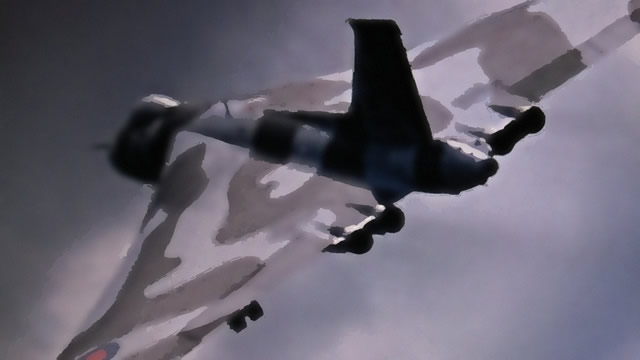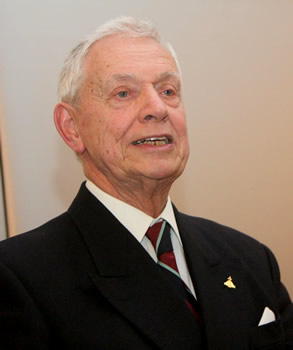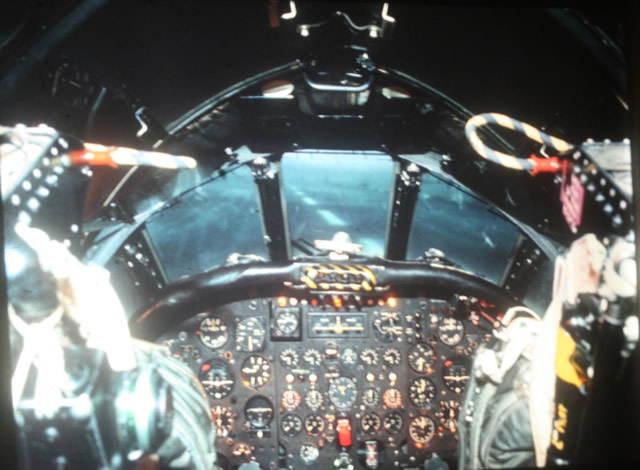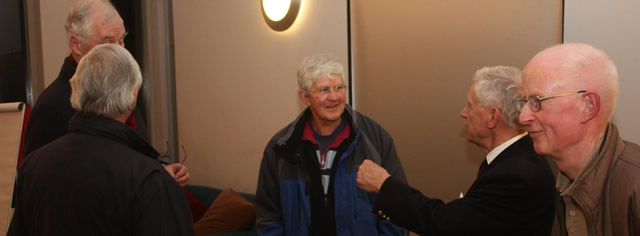The Vulcan Bomber – A Unique Experience

At Wincanton Museum and History Society's recent talk on28th February, Wing Commander Tony Lewis slipped in a chilling and unique experience for most of us there.
At the start of the evening, as people arrived, he passed around a heavy metal and plastic piece of equipment which he described as the Vulcan joy stick. It also had on it several buttons. Dutifully we handled it and passed it on. Then Tony started talking.
The Cold War Gets Going
 Well illustrated with slides, Tony took us right through his career from the time he joined the RAF as a keen young pilot flying propeller-driven bombers after the Second World War and his move to jets.
Well illustrated with slides, Tony took us right through his career from the time he joined the RAF as a keen young pilot flying propeller-driven bombers after the Second World War and his move to jets.
The fifties saw the start of the Cold War and the acquisition of nuclear weapons by the Soviet Union and of the hydrogen bomb by the UK and the US. This meant Russia, the UK and the US possessed weapons capable of catastrophic destruction. How, though, to deliver them? The Americans and Russians had long range bombers and soon Britain lagged behind, until the development of the delta-winged Vulcan, which was deployed in 1962. With four huge engines it was capable of very rapid take off and the ability to fly higher and faster than any Russian fighter or bomber.
In a light-hearted style and with many service jokes and tales of camaraderie Tony made us aware of just what that entailed. With a crew on board of four (pilot, co-pilot, navigator and electronic counter measures officer) the Vulcan carried no defensive weapons. Behind them on the ground was a large dedicated air-crew devoted to seeing that this huge, complex, yet fragile machine was kept in combat ready condition.
The MAD Vulcan role
Going on duty was no ride in the park. The military doctrine was known as MAD. Mutually Assured Destruction. When on duty the aircrew were kept dressed and ready for take-off and the ground-crew had the plane completely ready. As they once demonstrated at Farnborough, they could get airborne in a minute and a half from the call to scramble. Usually that would be a test run and they would return and stand down, but every time they took off all they knew was this was a one-way journey and that their task was to take out a Russian city with an H-bomb.

The Russians were the first to develop Intercontinental Ballistic Missiles and the RAF knew that once those were launched their time to respond was limited. As a result, on 1st February 1962, V-force started its Quick Reaction Alert readiness commitment. This meant having one loaded weapon system and crew per operational squadron - normally at 15 minutes readiness, reduced to four minutes at times of tension – on duty at all times. The Vulcan was, however, not capable of going supersonic, so it was replaced by the Hurricane fighter bomber.
In 1969 the UK nuclear deterrent ceased to be air-based and was replaced by the nuclear submarine Polaris Missile System, which we still have today.
The Vulcans Final Bombing Raid
The increasingly ancient Vulcans were then reconfigured for maritime radar reconnaissance duties, but in 1982 some were kitted out as bombers and they were used with extreme bravery and much improvised skill in a long-distance bombing raid on the Port Stanley airfield in the Falklands War. This could easily have seen both the Vulcans and the planes that re-fuelled them running out of fuel and being lost at sea. Amazingly their raid was successful.
And what about those joy sticks with their buttons? Tony pointed out that one of them was the trigger which would have released the Vulcan's H bomb. Yes, we had actually touched it.

The Museum and History Society Meetings
Tony Lewis' talk was very well attended, not only by members but by visitors, including a group of RAF veterans who meet together regularly. One of their number, however, came up specially from London.
The next date for your diary is Friday 28th March when our outgoing chairman Dr Terry Stanford will be speaking on "A social History of Beer. AKA the History of Mankind".
Comments
Posts: 1
Reply #1 on : Thu March 20, 2014, 12:30:37
Posts: 1
Reply #2 on : Thu March 20, 2014, 12:44:32
Posts: 1
Reply #3 on : Wed March 26, 2014, 14:24:58
Login to comment!